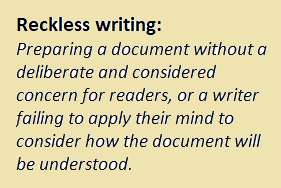Due diligence: action that is considered reasonable for people to be expected to take in order to keep themselves or others and their property safe. (Cambridge English Dictionary – my emphasis)
Businesses and government agencies write public documents to inform people about products, services, obligations and opportunities. People may be harmed if they do not fully understand fact sheets, letters, contracts, websites and the like. They may not receive the product or service they expect, they may act in a damaging way, or they miss out on something due to them.
The impact of misunderstanding may be serious or trivial. If the document is about a work process, misunderstanding may result in death or injury. If it is about a financial product, misunderstanding may lead to poverty and disadvantage.
The development process for most public documents is something like
- a junior person writes a first draft
- a manager reviews and edits the draft
- the marketing people provide input
- the legal department review, to make sure there is no risk to the organisation
- final graphic design and publish.
Organisations may perform these steps with skill and care, but that is not due diligence. It is merely people internal to the organisation talking to each other about the document. They make untested assumptions about how the target audience will understand and react to the document.
Document testing is both reasonable and necessary for public documents
Testing helps keep other people safe. Document testing checks the information can be read, understood and acted on before it is published.
Choosing not to test is reckless. Simply passing a document around the organisation and throwing it out to the public is not reasonable or responsible. We would never allow a physical product to enter the public arena that way – why do we tolerate it with information products?
Simply passing a document around the organisation and throwing it out to the public is not reasonable or responsible. We would never allow a physical product to enter the public arena that way – why do we tolerate it with information products?
Document testing is not difficult, expensive or time consuming. You can find most usability problems by testing with just a handful of potential users.
